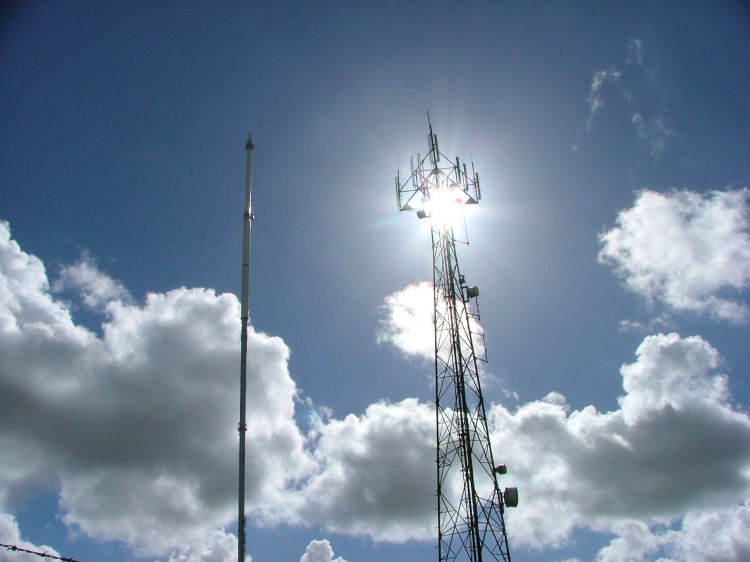 |
UK Broadcast Transmission |
|
|||||||||||
THE TRANSMISSION GALLERY
WINTER HILL
| Photos by Malcolm Pritchard and Simon Dee; notes by Russ J Graham and Tony Lyons | Page last updated: 2017-12-24 |
| The original establishment of the Winter Hill site was very difficult - hence (according to one theory) the name. Early references to the proposed north-west area transmitter refer to "the Bolton transmitter", which is logical from the point of view of Bolton being probably the logical location for the mast given the ITA's hoped-for coverage pattern. When planning permission was being sought, the site was referred to by its actual location - Rivington Moor. The name Rivington Moor appears in all documentation until the Winter of 1955/56. This winter wasn't that severe - unpleasant, but nothing like 1947, 1974/75 or several other "bad" winters of folk memory. But high up on the moors around Bolton, whilst trying to build - against a deadline - a huge open-lattice mast plus associated control room, switching centre and GPO links, the team of engineers can be forgiven for renaming the site. They faced constant delay, days when visibility dropped to zero, temperatures well into the screaming brass monkey zone and high winds driving snow and hail into huge, seemingly impregnable drifts. The name they chose supplanted the original Rivington Moor, and was adopted by the ITA. To this day, a trip on the train past Bolton gives you a wonderful view of the mast, but the desolation and isolation of the site can still be seen. It is, almost literally, in the middle of nowhere, and contrives to look like a cold and unforgiving landscape even from the warmth of a (former) British Rail train on a bright summer's day. The ideal location for a film adaptation of Wuthering Heights, maybe - apart from being on the wrong side of the Pennines and having a bloody great tubular steel transmitting mast in the middle of it! But there's an alternative explanation for the place-name, so just what IS it called? According to a Hikers & Hill Walkers Book titled The West Pennine Moors, Winter Hill is the highest point of Rivington Moor. The book goes on to say that in Saxon times the Hill was known as Edgar's Hill, named after a local Saxon Chieftain. However some time later its name was changed to Wintry Hold Hill. The reason for this was due to local villagers storing food there - especially meat - in huts in the winter time to keep it fresh. The named was then shortened in more recent times to Winter Hill. The main (S1) UHF transmit aerial at Winter Hill, with a mean height of 726m aod, are the highest in the UK UHF transmitter network. |


| It seems that all six tubular steel masts built in Britain (Winter Hill, Belmont, Mendip, Bilsdale, Waltham and, of course, the ill-fated 1265 foot mast at Emley Moor) originally had lifts installed. The lifts were designed to carry the aerial riggers to the top of the tubular steel section. Ascent of the weather shield protected lattice transmitting aerial support section was made by ladder. The idea of this feature was to protect the riggers against the wind & weather that they were subjected to working on lattice steel masts & towers. Another useful feature is that the aircraft warning lamps can be swung in internally so that they can be changed. In recent Years NTL have fitted 150 tons of damping chains at Winter Hill & Belmont to reduce the oscillations caused by high winds that were a factor in the collapse of the Emley Moor Mast in 1969. |

| This photo was taken in approximately 1987 or 1988... "in the days before fences, when you could sit with you back against the louvered shutters at the base of the mast eating your sandwiches, or alternately sunbathe on the massive concrete cable anchors." Winter Hill service dates 3rd May 1956 ITV (Granada) launches on VHF channel 9 from a 450ft tower. 20th April 1964 BBC 1 in service on VHF channel 12. 31st October 1965 BBC 2 in service from the new 309.4m cylindrical mast on UHF channel 62. 28th February 1966 ITV transferred to new higher aerials on the new mast 25th March 1966 BBC 1 transferred new higher aerials on the new mast. 1st July 1967 Start of colour transmissions on BBC 2. 15th November 1969 Launch of BBC 1 & ITV UHF colour transmissions. UHF channels 55 & 59. 2nd October 1982 Launch of ILR Preston & Blackpool (Red Rose Radio) on 97.3 MHz. 2nd November 1982 Launch of Channel 4 on UHF channel 65. January 1985 BBC 1 & ITV VHF 405-line transmissions close. August 1986 BBC National FM radio in service. Radio 1 from 6th October 1990. August 1986 Radio Lancashire in service on 103.9 MHz. 1988 ILR Preston and Blackpool frequency changed to 97.4 MHz. 1st September 1994 Launch of JFM on 100.4 MHz. 30th March 1997 Launch of Channel 5 on UHF channel 48. 22nd October 1997 BBC National DAB in service. 8th September 1998 Launch of Century FM on 105.4 MHz. 16th September 1999 Digital One DAB in service. 10th May 2000 Manchester DAB in service. 30th August 2001 North-West DAB in service. Closed 24/9/2013. 26th September 2001 Lancashire DAB in service. 4th November 2009 DSO 1. 2nd December 2009 DSO 2 and launch of G-MAN TV mux. 26th November 2013 TV mux Com 7 in service. 26th June 2014 Liverpool, Manchester & Preston local TV in service. 21st April 2015 TV mux Com 8 in service. 29th February 2016 SDL DAB launches. 25/5/2016 Manchester DAB channel changed from 11C to 12C. 19/5/2016 Liverpool DAB in service. |
More photos of Winter Hill
The Winter Hill UHF aerial
The Winter Hill BBC 1 VHF aerial
| |
Back to TX Gallery index | TX main index
|